Bat Trang Pottery Village
Ways to Experience this attraction
Bat Trang Pottery Village, Hanoi Overview
Bat Trang Pottery Village, popularly known as the 'Ceramic Village' is home to many local artisan families who excel at traditional as well as modern designs. Located in the Gia Lam District left of the Red River, there are many stores and workshops where you can not only purchase alluring ceramic products like vases, plates and bowls, but also watch them being made and learn.
With the advantage of a beautiful region rich in clay, the Bat Trang Pottery Village makes the most beautiful ceramics in Vietnam. Of course, Bat Trang's practices of pottery have seen great innovation in the last few decades - from a fairly tedious process made by hand with relatively similar designs, pottery in this village has been transformed by production practices and creativity in design. Not only can you buy everyday items like pots and plates now, but you can splurge on decorative items like vases and even idols for worshipping. In most instances, you'll even get to watch your items be made before your own eyes, making these treasures all the more special.

Colourful Narrow Lanes and Traditional Vietnamese Arts (Source)
At Bat Trang Pottery Village, you'll get a chance to explore its small lanes and visit little workshops, or even enjoy a unique sightseeing tour on a water buffalo. The Pottery Market has thousands of ready-made designs on sale. The village is full of warm, friendly locals who love sharing their craft with the world, assuring it as an amazing location to enjoy a day near Hanoi.
Bat Trang Pottery Village Class

In order to obtain the most unique products, you can enjoy the experience of making them yourselves at Bat Trang. Almost all tours to Bat Trang Pottery Village include this important element of interacting with the locals, learning some of their skills, and allowing them to help you make your very own ceramic product. At the Pottery market, there are plenty of families that offer this service for anywhere between VND 40,000 (INR 120) to VND 60,000 (INR 180) for the entire experience. First, you'll be given moist clay at your turntable station where you can mould it as you please. There's a great deal of freedom given to you, allowing your imagination and creativity to run wild. If you're a little unsure, the artisans are always ready to help you craft a beautiful product, and correct any blemishes.

Pottery Village by Decorating it (Source)
A clay product will take around half an hour to dry properly, after which the artisans bake it further and glaze it for that perfect color and shine. During this waiting time, you can explore the village and see what kinds of items are on offer elsewhere. When your item is ready, you can come back to see how it looks in its final decorated state. For an additional price, it’s yours for the keeping! There's no better way to truly appreciate the craftsmanship and skills of the Bat Trang artisans than getting a chance to create something for yourself.
Bat Trang Pottery Village Products

Vietnamese Ceramics
Because of its rich history of pottery, the artisans here have practically perfected the art of pottery. This village's products are widely renowned for their high quality, wide range of designs, colors, and types of items. Although they are produced through a partly-mechanised process, a lot of ceramics at Bat Trang has a human element in its creation, making each piece utterly unique. There are certain patterns, designs, and colors that will recur between stores during your explorations. According to the village craftsmen, the most popular products to be created and sold contain images of phoenixes, dragons, nature, and most importantly, depictions of the lives of Vietnamese people, especially their inherent spirituality and philosophy. You'll find them in all kinds of ceramics like plates, mugs, cups, jars, vases, and so on.
Bat Trang Pottery Village Activities

As soon as you turn off the main road into the village lanes, you'll notice that most of these little lanes leading left and right, directing you in apparent circles, lead into the village centre where the main market is situated. This centre is called "cho". It is the heart of Bat Trang Pottery Village where you'll find all the shops and restaurants, making it the tourist hub of this area. Just beside the market, you'll even see the traditional coal kilns where the ceramics have historically been heated and dried aside from the old-school style of pat-drying on walls. These kilns are off-limits for tourists. Entry as well as photography is forbidden here.
The best way to experience the village is by travelling on a traditional cart pulled by a water buffalo. These cards accommodate almost 10 people each and can be rented by hour. Just imagine how thrilling it must be to see the village from the back of a cart, rocking back and forth while marvelling at the ceramic wonders around you! A buffalo vehicle can be rented for anywhere between VND 150,000 (INR 450) to VND 200,000 (INR 600). You'll see tons of these buffalo vehicles at the village's shopping centre.

Market (Source)
Aside from the shopping centre, Bat Trang has Van Van House and Ceramic Village that should definitely not be missed during your trip. Did you know that Van Van House is believed to house more than 400 items of pottery that date back as early as the 15th century? There are dozens of little shops and street vendors selling authentic ceramics from cups and wind chimes to bracelets and dinner plates. Even if you aren't interested in purchasing any items, walking through the shopping centre can be an exciting experience. It's full of street vendors hawking loudly, plenty of colourful pottery all around, and even the aroma of delicious food wafting from food stalls. You'll get to meet the hospitable locals who love to show off their items and aren't shy to pose for photographs!
Bat Trang Pottery Village History

According to the Complete Annals of Dai Viet, Bat Trang Pottery Village was created in the 14th century by local artisans who came together to combine techniques and resources towards their artworks. However, local legends from this community insist that the village existed in as early as the 10th century under the Ly dynasty. When the king moved the capital of Vietnam to Thang Long, merchants and craftsmen thronged to the area to sell their products, eventually creating the crafts village it is today.
Economic reforms in the 20th century brought resurgence in trade of artisanal products. It became a staple for pottery products in Asia. During Vietnam's colonial period, these products travelled as far as France and Italy too. In the last decade, Bat Trang's ceramics have been particularly popular around the world. Some products from the village can be found in prolific museums like the Guimet Museum in France and the Royal Museum of Fine Arts in Belgium.
How to Reach Bat Trang Pottery Village

Vietnam (Source)
Bat Trang Pottery Village can be found on the left bank of the Red River. It is approximately 15 kilometres south of Hanoi in the Gia Lam district. If you'd like to rent a taxi or a motorbike, it will take less than half an hour to reach this pottery village from Hanoi, and will cost around VND 150,000 (INR 450) to VND 200,000 (INR 600). There are public transport options available as well that are cheaper and much more convenient. You can easily catch Bus 47 from Long Bien Street in Hanoi to Bat Trang Pottery Village that runs every half hour. This will only cost VND 15,000 (INR 45).
Best Time to Visit Bat Trang Pottery Village
The best time to visit the Bat Trang Pottery Village is between September and April. In the monsoon months, the village becomes quite wet and its clay soil makes for a very mucky experience.Tips for Visiting Bat Trang Pottery Village

Pottery Village (Source)
- Because you'll be interacting with buffalos and playing with clay at Bat Trang, it's a good idea to dress comfortably in clothes that you wouldn't mind getting a little dirty. You definitely don't want to visit this pottery village dressed in white!
- Although the pottery workshops here cost around VND 40,000, don’t forget that this is just for the clay moulding experience. If you'd like to further decorate your items, there are additional charges of around VND 50,000 (INR 50) per item. And if you'd like to keep your item to take back home, you’ll need to pay around VND 25,000 (INR 760).
- As you'll get to witness traditional Vietnamese life at Bat Trang Pottery Village, there are also plenty of delicious food options that you shouldn't miss. We'd recommend trying out the ca phe trung, the rich, creamy egg coffee best known in Vietnam.
- Bat Trang is not too far from Hanoi, so it's best enjoyed as a short day trip. Accommodations for overnight stays or multiple day visits are few and scarce here.

From getting to wander in a traditional Vietnamese village to enjoying the opportunity to create your own ceramic products, Bat Trang is a wonderful day trip out of the bustle of Hanoi's city life.
Read More on Bat Trang Pottery Village
Bat Trang Pottery Village History
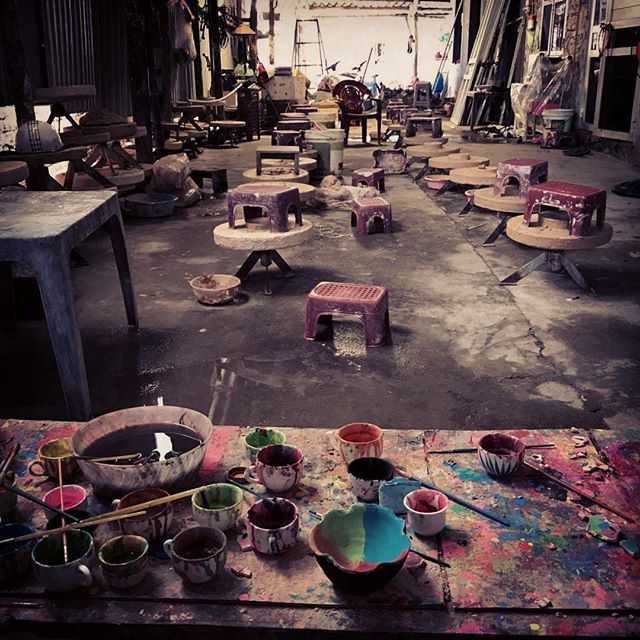
According to the Complete Annals of Dai Viet, Bat Trang Pottery Village was created in the 14th century by local artisans who came together to combine techniques and resources towards their artworks. However, local legends from this community insist that the village existed in as early as the 10th century under the Ly dynasty. When the king moved the capital of Vietnam to Thang Long, merchants and craftsmen thronged to the area to sell their products, eventually creating the crafts village it is today.
Economic reforms in the 20th century brought resurgence in trade of artisanal products. It became a staple for pottery products in Asia. During Vietnam's colonial period, these products travelled as far as France and Italy too. In the last decade, Bat Trang's ceramics have been particularly popular around the world. Some products from the village can be found in prolific museums like the Guimet Museum in France and the Royal Museum of Fine Arts in Belgium.
Tips for Visiting Bat Trang Pottery Village
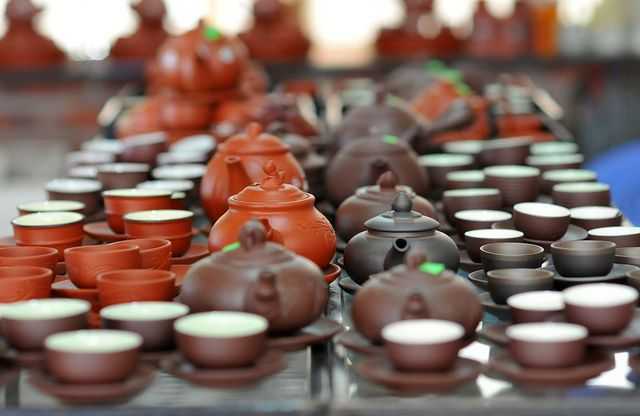
Pottery Village (Source)
- Because you'll be interacting with buffalos and playing with clay at Bat Trang, it's a good idea to dress comfortably in clothes that you wouldn't mind getting a little dirty. You definitely don't want to visit this pottery village dressed in white!
- Although the pottery workshops here cost around VND 40,000, don’t forget that this is just for the clay moulding experience. If you'd like to further decorate your items, there are additional charges of around VND 50,000 (INR 50) per item. And if you'd like to keep your item to take back home, you’ll need to pay around VND 25,000 (INR 760).
- As you'll get to witness traditional Vietnamese life at Bat Trang Pottery Village, there are also plenty of delicious food options that you shouldn't miss. We'd recommend trying out the ca phe trung, the rich, creamy egg coffee best known in Vietnam.
- Bat Trang is not too far from Hanoi, so it's best enjoyed as a short day trip. Accommodations for overnight stays or multiple day visits are few and scarce here.
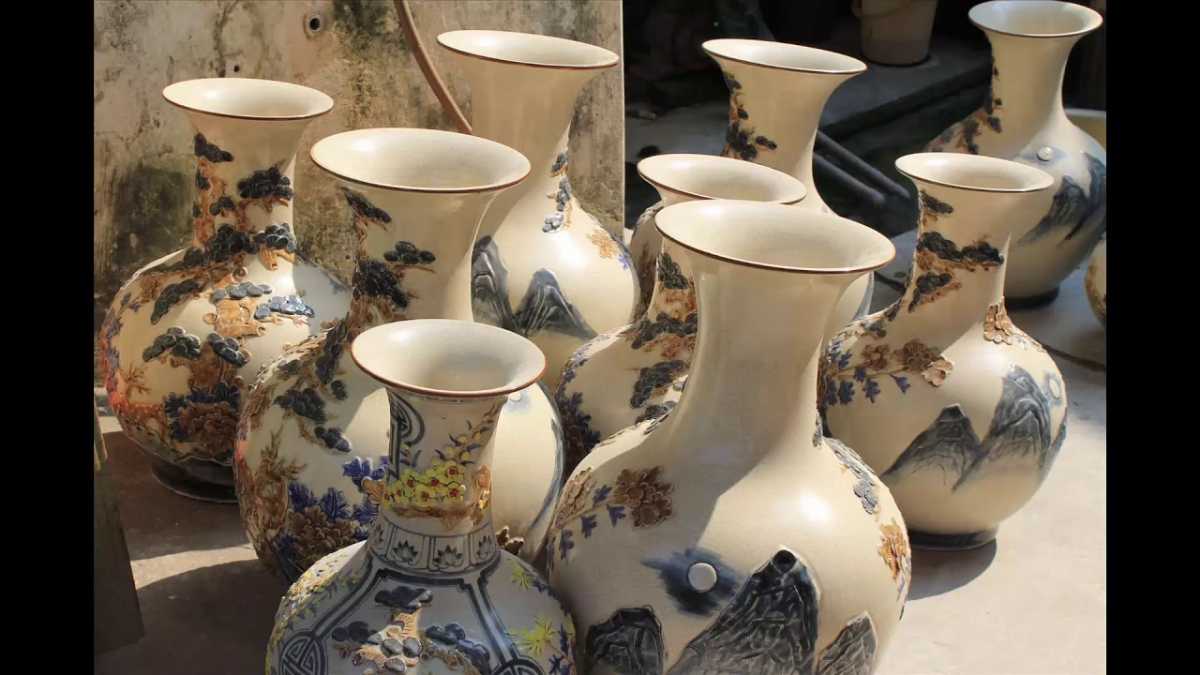
From getting to wander in a traditional Vietnamese village to enjoying the opportunity to create your own ceramic products, Bat Trang is a wonderful day trip out of the bustle of Hanoi's city life.
How to Reach Bat Trang Pottery Village
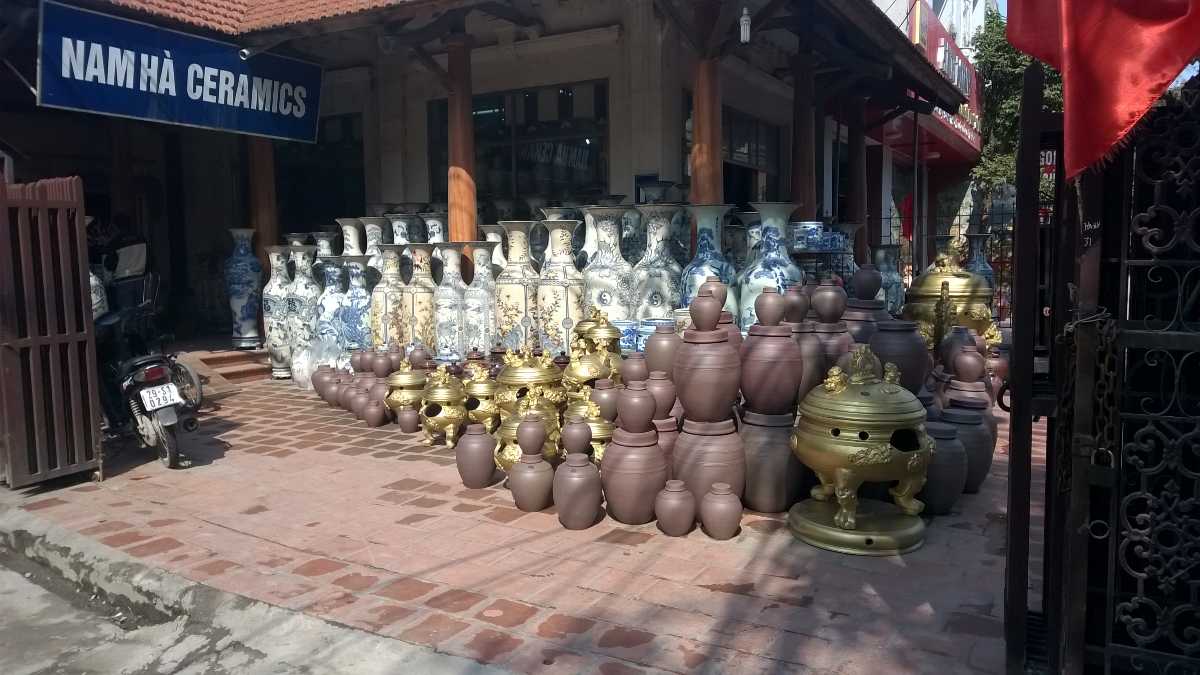
Vietnam (Source)
Bat Trang Pottery Village can be found on the left bank of the Red River. It is approximately 15 kilometres south of Hanoi in the Gia Lam district. If you'd like to rent a taxi or a motorbike, it will take less than half an hour to reach this pottery village from Hanoi, and will cost around VND 150,000 (INR 450) to VND 200,000 (INR 600). There are public transport options available as well that are cheaper and much more convenient. You can easily catch Bus 47 from Long Bien Street in Hanoi to Bat Trang Pottery Village that runs every half hour. This will only cost VND 15,000 (INR 45).
Bat Trang Pottery Village Products
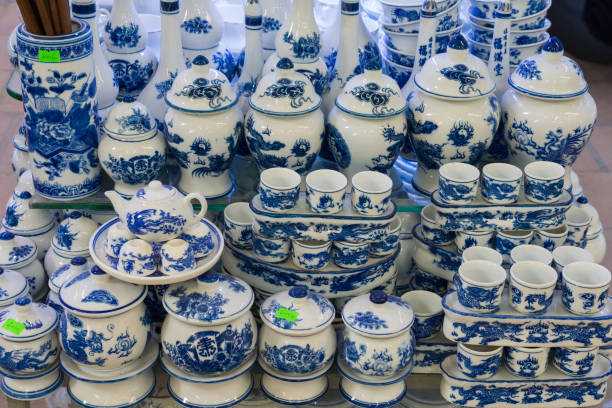
Vietnamese Ceramics
Because of its rich history of pottery, the artisans here have practically perfected the art of pottery. This village's products are widely renowned for their high quality, wide range of designs, colors, and types of items. Although they are produced through a partly-mechanised process, a lot of ceramics at Bat Trang has a human element in its creation, making each piece utterly unique. There are certain patterns, designs, and colors that will recur between stores during your explorations. According to the village craftsmen, the most popular products to be created and sold contain images of phoenixes, dragons, nature, and most importantly, depictions of the lives of Vietnamese people, especially their inherent spirituality and philosophy. You'll find them in all kinds of ceramics like plates, mugs, cups, jars, vases, and so on.
Bat Trang Pottery Village Class
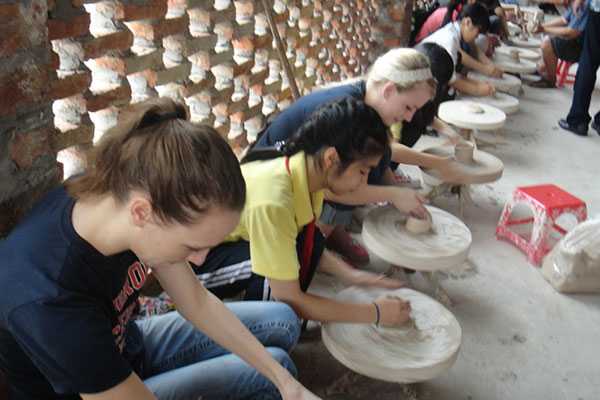
In order to obtain the most unique products, you can enjoy the experience of making them yourselves at Bat Trang. Almost all tours to Bat Trang Pottery Village include this important element of interacting with the locals, learning some of their skills, and allowing them to help you make your very own ceramic product. At the Pottery market, there are plenty of families that offer this service for anywhere between VND 40,000 (INR 120) to VND 60,000 (INR 180) for the entire experience. First, you'll be given moist clay at your turntable station where you can mould it as you please. There's a great deal of freedom given to you, allowing your imagination and creativity to run wild. If you're a little unsure, the artisans are always ready to help you craft a beautiful product, and correct any blemishes.
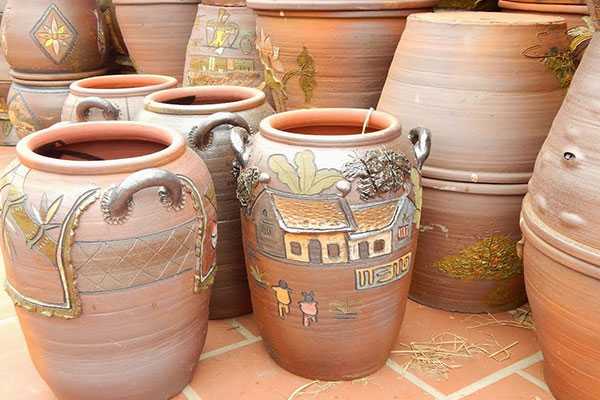
Pottery Village by Decorating it (Source)
A clay product will take around half an hour to dry properly, after which the artisans bake it further and glaze it for that perfect color and shine. During this waiting time, you can explore the village and see what kinds of items are on offer elsewhere. When your item is ready, you can come back to see how it looks in its final decorated state. For an additional price, it’s yours for the keeping! There's no better way to truly appreciate the craftsmanship and skills of the Bat Trang artisans than getting a chance to create something for yourself.
Bat Trang Pottery Village Activities
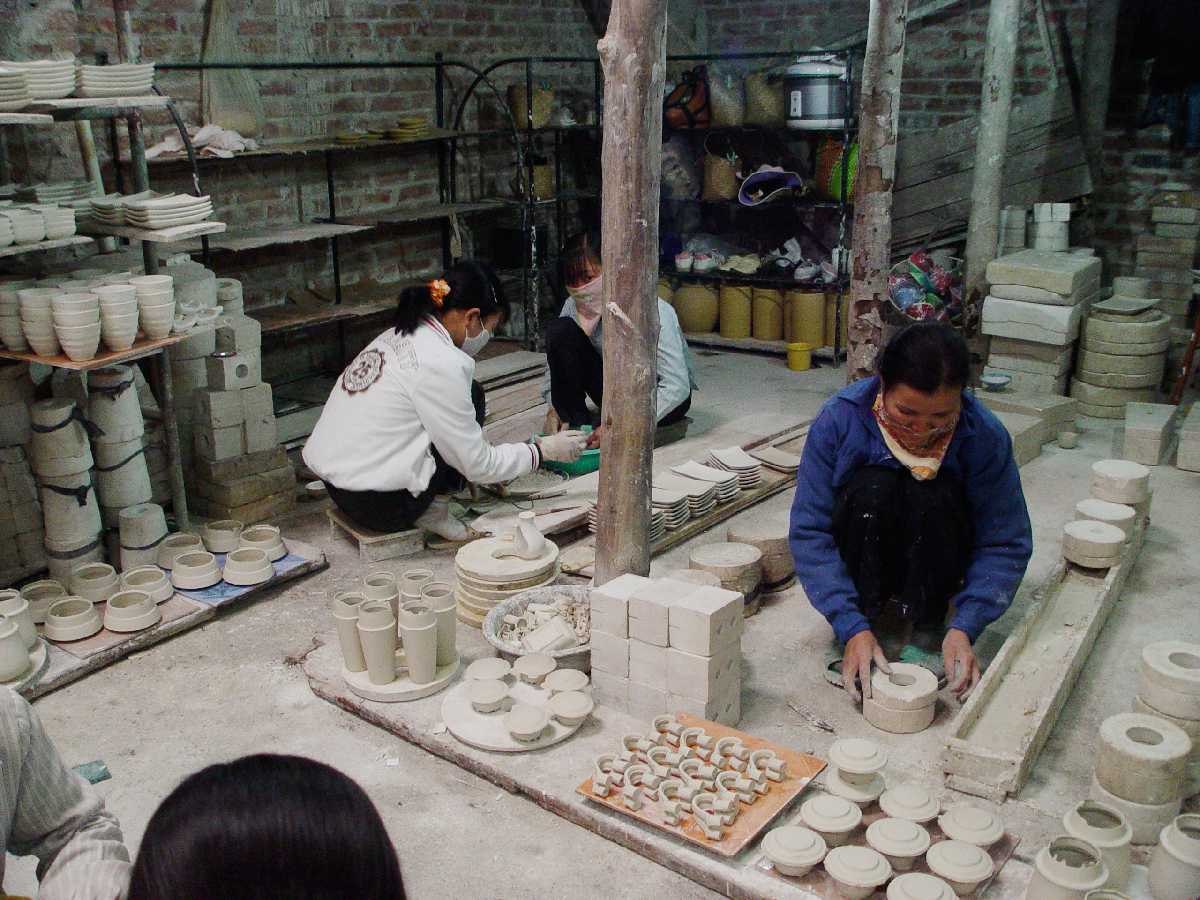
As soon as you turn off the main road into the village lanes, you'll notice that most of these little lanes leading left and right, directing you in apparent circles, lead into the village centre where the main market is situated. This centre is called "cho". It is the heart of Bat Trang Pottery Village where you'll find all the shops and restaurants, making it the tourist hub of this area. Just beside the market, you'll even see the traditional coal kilns where the ceramics have historically been heated and dried aside from the old-school style of pat-drying on walls. These kilns are off-limits for tourists. Entry as well as photography is forbidden here.
The best way to experience the village is by travelling on a traditional cart pulled by a water buffalo. These cards accommodate almost 10 people each and can be rented by hour. Just imagine how thrilling it must be to see the village from the back of a cart, rocking back and forth while marvelling at the ceramic wonders around you! A buffalo vehicle can be rented for anywhere between VND 150,000 (INR 450) to VND 200,000 (INR 600). You'll see tons of these buffalo vehicles at the village's shopping centre.
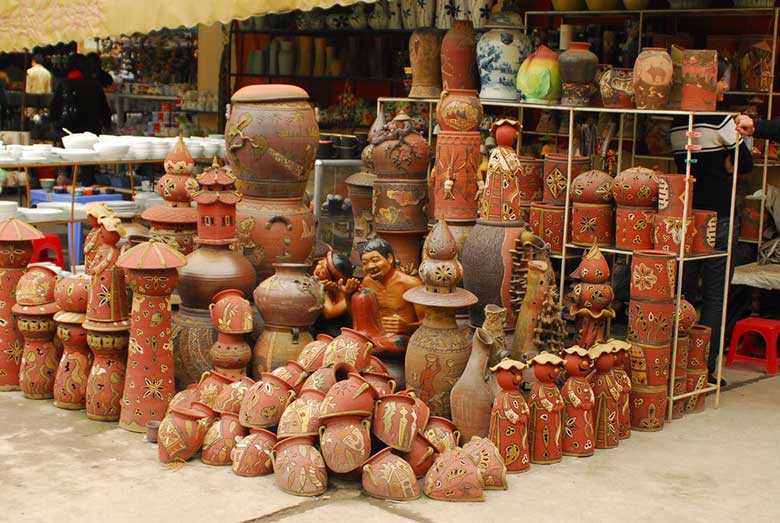
Market (Source)
Aside from the shopping centre, Bat Trang has Van Van House and Ceramic Village that should definitely not be missed during your trip. Did you know that Van Van House is believed to house more than 400 items of pottery that date back as early as the 15th century? There are dozens of little shops and street vendors selling authentic ceramics from cups and wind chimes to bracelets and dinner plates. Even if you aren't interested in purchasing any items, walking through the shopping centre can be an exciting experience. It's full of street vendors hawking loudly, plenty of colourful pottery all around, and even the aroma of delicious food wafting from food stalls. You'll get to meet the hospitable locals who love to show off their items and aren't shy to pose for photographs!
Best Time to Visit Bat Trang Pottery Village
Top Hotel Collections
Top Hotels Near Bat Trang Pottery Village
Bat Trang Pottery Village Reviews

Have a Question on Bat Trang Pottery Village?

experience.